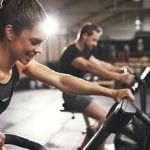Pole fitness has gained popularity in recent years as a unique and challenging form of exercise that combines strength, flexibility, and grace. What kind of workout is pole fitness? It is a full-body workout that focuses on using a vertical pole to perform various movements and poses that engage different muscle groups.
The roots of pole fitness can be traced back to traditional Chinese pole dancing and Indian Mallakhamb, but it has evolved into a modern form of exercise that incorporates elements of dance, gymnastics, and acrobatics. Over time, pole fitness has transitioned from its origins as entertainment in strip clubs to a mainstream fitness activity for individuals looking to build strength, increase flexibility, and improve cardiovascular health.
One of the key benefits of pole fitness is its ability to target multiple aspects of physical fitness simultaneously. Participants can expect improvements in core strength, upper body endurance, lower body flexibility, and overall cardiovascular conditioning.
Additionally, the mental aspect of pole fitness cannot be overlooked, as it requires focus, concentration, and perseverance to master new moves and routines. Stay tuned as we delve deeper into the world of pole fitness to uncover its history, benefits, myths, styles, and insider tips for those considering starting classes.
The History and Origins of Pole Fitness as Exercise
Pole fitness, often associated with exotic dancing or stripping, has a rich history that dates back to ancient times. The roots of pole dancing as a form of exercise can be traced back to Indian Mallakhamb, a traditional sport that combines yoga and gymnastics using a vertical wooden pole. This practice later evolved into Western pole fitness as we know it today.
In the 1980s, pole dancing gained popularity in strip clubs, but it wasn’t until the early 2000s that it transitioned into a mainstream form of fitness. Fawnia Mondey is credited as one of the pioneers who helped legitimize pole dancing as a workout by opening the first-ever pole dancing fitness studio. Over time, pole fitness classes began catering to individuals looking for a fun and challenging way to improve strength, flexibility, and overall health.
Today, pole fitness has become more widely accepted and embraced by people of all ages and body types. It has grown beyond its sensual connotations to be recognized as a legitimate form of exercise that offers numerous physical and mental benefits. As individuals seek alternative ways to stay active and fit, pole fitness continues to gain traction in the fitness industry as an empowering and effective workout regimen.
| Benefits | Details |
|---|---|
| Strength Improvement | Pole fitness requires engaging multiple muscle groups simultaneously leading to enhanced strength. |
| Flexibility Enhancement | The various movements on the pole help increase flexibility through dynamic stretching exercises. |
| Cardiovascular Fitness | Pole routines involve continuous movement which can elevate heart rate for cardiovascular endurance. |
Benefits of Pole Fitness
Pole fitness is a unique form of exercise that combines strength training, flexibility, and cardio all in one workout. Many people may wonder what kind of workout pole fitness actually is, and the answer lies in its multifaceted nature. When you engage in pole fitness, you are not just performing acrobatic moves on the pole; you are also working on improving your overall physical fitness.
One of the key benefits of pole fitness is its ability to build strength. By using your own body weight as resistance, you can target various muscle groups such as your arms, core, back, and legs. The dynamic movements and holds required in pole fitness require significant upper body and core strength to execute properly. Over time, consistent practice can lead to noticeable improvements in muscle tone and definition.
In addition to strength training, pole fitness also helps improve flexibility. The fluid motions and stretches involved in executing different pole moves can enhance your range of motion and overall flexibility. This is particularly beneficial for individuals who may have tight muscles or limited mobility. As you progress in your pole fitness journey, you may find yourself becoming more supple and agile due to regular stretching and conditioning exercises.
| Aspect | Benefits |
|---|---|
| Strength Training | Builds upper body, core, back, and leg muscles |
| Flexibility | Enhances range of motion and overall flexibility |
Different Styles of Pole Fitness
Exploring Different Levels of Pole Fitness
Pole fitness offers a versatile range of styles to cater to individuals with varying levels of experience and fitness goals. Beginners are often introduced to basic spins, climbs, and poses to build essential strength and coordination. As participants progress, they can move on to more advanced techniques like inversions, holds, and dynamic combinations that challenge both their physical strength and creativity on the pole.
Transitioning From Beginner to Intermediate Levels
As students advance in their pole fitness journey, they will gradually incorporate more complex maneuvers and seamless transitions between moves. Intermediate classes typically focus on refining technique, building endurance, and exploring different movement styles such as sensual flow or power tricks. This stage requires consistent practice and dedication to master challenging tricks while maintaining fluidity in routines.
Moving Beyond Intermediate to Advanced Pole Fitness
Advanced pole fitness classes push participants to explore intricate combinations, dynamic spins, and acrobatic stunts that require a high level of strength, flexibility, and agility. Students at this level often focus on developing their own unique style by experimenting with complex sequences that showcase their individual strengths. Advanced polers may also have the opportunity to participate in competitions or performances to demonstrate their skill and artistry in pole dance.
Myths About Pole Fitness Debunked
When it comes to pole fitness, there are often misconceptions and myths that surround this form of exercise. One common myth is that pole fitness is only for exotic dancers or those in the adult entertainment industry. In reality, pole fitness has evolved into a legitimate form of exercise that focuses on strength, flexibility, and overall physical fitness. It is a challenging workout that requires dedication and skill, regardless of one’s background or profession.
Another myth about pole fitness is that it is only for women. While it is true that the majority of participants in pole fitness classes are female, men can also benefit from this type of workout. In fact, many men are beginning to embrace pole fitness as a way to improve their strength, flexibility, and body awareness. It is important to remember that pole fitness is inclusive and welcoming to people of all genders and backgrounds.
Additionally, some may believe that pole fitness is solely focused on performing tricks and gravity-defying stunts. While these elements are certainly part of advanced pole routines, beginners start with basic moves and gradually progress as they build strength and confidence.
Pole fitness combines elements of dance, gymnastics, and strength training to provide a full-body workout that challenges both the body and mind. Overall, the myths surrounding pole fitness should not deter anyone from exploring this unique and empowering form of exercise.
The Physical and Mental Transformation Through Pole Fitness
Pole fitness is a unique form of exercise that not only challenges the body physically but also brings about positive mental transformations. Through regular practice, individuals can experience significant changes in their overall health and well-being. Here are some key aspects of the physical and mental transformation that can be achieved through pole fitness:
- Physical Strength: Pole fitness requires a great deal of upper body and core strength to execute various moves and tricks. Regular training helps to build muscles, improve endurance, and enhance overall physical strength.
- Flexibility: Pole dancing involves a wide range of dynamic movements that require flexibility in different muscle groups. Consistent practice can lead to improved flexibility, better range of motion, and reduced risk of injuries.
- Confidence and Empowerment: Mastering new pole techniques and routines can boost self-confidence and provide a sense of empowerment. Overcoming personal challenges and achieving goals in pole fitness can have a profound impact on mental well-being.
Moreover, pole fitness is not just about physical gains; it also offers numerous mental benefits. It encourages practitioners to step out of their comfort zones, overcome fears, and embrace their bodies in a positive light. The supportive community within the pole fitness world provides encouragement, camaraderie, and a sense of belonging, which can contribute to improved mental health.
Overall, the physical and mental transformations through pole fitness go hand in hand, creating a holistic approach to health and well-being. As individuals progress in their pole journey, they often discover newfound strength, resilience, creativity, and self-expression. The combination of physical challenges and mental growth make pole fitness a truly transformative workout regimen that can positively impact all aspects of life.
Tips for Starting Pole Fitness Classes
Choosing the Right Studio
When starting pole fitness classes, it is essential to choose the right studio that suits your needs and preferences. Look for a studio that offers classes for beginners, as well as more advanced students. It is also important to consider the instructor’s experience and qualifications. Make sure to visit the studio in person, if possible, to get a feel for the atmosphere and see if it aligns with what you are looking for in your pole fitness journey.
Gear and Attire
One of the key aspects of starting pole fitness classes is having the appropriate gear and attire. Most studios will require students to wear shorts and a tank top or sports bra for better grip on the pole. It is also recommended to bring a water bottle and a towel, as pole fitness can be quite physically demanding. Additionally, invest in a good pair of pole dance shoes or grips to enhance your performance and prevent injuries during your workouts.
Setting Realistic Goals
Before starting pole fitness classes, take some time to set realistic goals for yourself. Whether you want to improve your strength, flexibility, or overall fitness level, having clear objectives can help keep you motivated throughout your journey. Remember that progress takes time, so be patient with yourself and celebrate even small achievements along the way. By setting achievable goals, you can track your progress and stay focused on what you want to achieve through pole fitness.
By following these tips for starting pole fitness classes, you can embark on a fulfilling and empowering journey towards improving your physical health and overall well-being through this unique form of exercise. Whether you are a beginner or have some experience with fitness activities, pole fitness offers an exciting and challenging workout that combines strength training, flexibility exercises, and cardio movements. Take the first step towards discovering what kind of workout is pole fitness by joining a class today.
Interview With a Pole Fitness Instructor
Pole fitness has gained popularity in recent years as a unique and empowering form of exercise that combines strength, flexibility, and grace. However, for those who are new to this type of workout, it can be intimidating to know where to start. That’s why we sat down with a seasoned pole fitness instructor to get some insider tips and advice on how to make the most of your pole fitness journey.
During our interview with Sarah Smith, an experienced pole fitness instructor with over 5 years of teaching under her belt, she emphasized the importance of understanding the basics before diving into more advanced moves. “Pole fitness is not just about spinning around a pole,” Sarah explained. “It requires a combination of strength training, flexibility work, and dance movements to truly excel in this form of exercise”.
Here are some valuable tips and advice from Sarah for those looking to start their pole fitness journey:
- Make sure to warm up properly before each session to prevent injury and improve performance.
- Focus on building both upper body and core strength through specific exercises like push-ups, planks, and pull-ups.
- Don’t be discouraged by initial challenges – progress takes time, so celebrate small victories along the way.
As Sarah puts it, “Pole fitness is not just a physical workout – it also challenges you mentally and emotionally. It’s about embracing your body’s capabilities and pushing yourself out of your comfort zone.” With the right mindset and dedication, anyone can reap the benefits of pole fitness and experience a transformative journey towards greater strength, confidence, and self-expression.
Conclusion
As we conclude our exploration of pole fitness, it is clear that this form of exercise offers a unique blend of strength training, flexibility improvement, and cardiovascular benefits. Through understanding the basics, delving into its history, and debunking myths surrounding pole fitness, we have shed light on what kind of workout it truly is. Whether you are a beginner looking to try something new or an experienced athlete seeking a challenging routine, pole fitness has something to offer for everyone.
One cannot overlook the physical and mental transformations that individuals can experience through their journey in pole fitness. From building confidence and empowerment to sculpting muscles and enhancing mobility, the impact of this form of exercise goes beyond just physical appearances. It is a holistic approach to health and wellness that encourages individuals to embrace their strength and capabilities in ways they may never have imagined.
In the end, starting pole fitness classes can be a rewarding step towards embracing empowerment both inside and outside the studio. As our interview with a pole fitness instructor has shown us, there is a supportive community waiting to welcome newcomers and guide them through their fitness journey. So, if you are curious about what kind of workout pole fitness entails, do not hesitate to take that first step towards discovering the many benefits it has to offer.
Frequently Asked Questions
What Kind of Exercise Is Pole Fitness?
Pole fitness is a combination of strength training, flexibility, and endurance exercises. It involves using a vertical pole to perform various acrobatic and dance movements that require a significant amount of core and upper body strength.
Is Pole Fitness a Full Body Workout?
Pole fitness is indeed a full-body workout. It engages muscles throughout the body, including the arms, shoulders, back, core, and legs. By incorporating dynamic movements like spins, climbs, and inversions, pole fitness helps tone and strengthen muscles from head to toe.
Is Pole Dancing Cardio or Strength?
Pole dancing can be both cardio and strength-focused depending on how it is practiced. The fast-paced routines with continuous movement can elevate the heart rate, making it a cardiovascular exercise. On the other hand, the need to support one’s own body weight during various poses builds strength in different muscle groups like the arms, core, and legs.

Passionate about providing useful information to anyone with an interest in the field of Personal Training, I strive to pass on to our readers quality information and to answer any questions about Personal Trainers, the work they do and how to become one.





